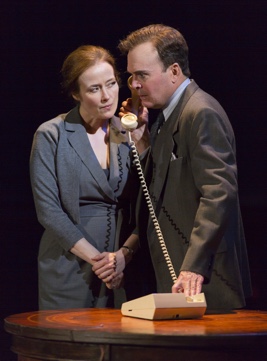The PLO and the Israelis behind Closed Doors in Oslo: The Play

Can you make a good drama out of secret political peace talks in which there are no car chases, homicidal threats or a love story?
You can if you are playwright J.T. Rogers, whose play Oslo just opened at the Vivian Beaumont Theater at Lincoln Center, in New York. Oslo is the story of a series of highly secret talks in Oslo, Norway, between representatives of Israel and the Palestinian Liberation Organization (PL0) in 1993. The talks were conducted at the same time that the very “official” talks were being held in Washington, D.C., and were going nowhere. The talks were facilitated by two Norwegian diplomats, Terje Rod-Larsen and his wife, Mona. It was a peace process rarely tried before and it worked. The two sides did reach an agreement, one which called for a Palestinian state, and the accord was formalized later at the White House.
Rogers’s play is full of human drama between the negotiators and it gets hotter and hotter as the three hour evening goes by. The negotiators like each other and hate each other, help each other and hurt each other, storm out furiously and come back quietly. Rogers is very good at deep characterizations and, at the same time, keeping up the intensity of the story. The key to all of this, though, is his ability to show us that diplomats are very real people, just like all of us, and they are very human behind all of the shouting and swagger.
As an example, there is a moment in the play when talks are going badly and the Israeli and Palestinian negotiators learn that they are both dads to little girls named Maya. That knowledge melts the ice between them and they become long-time friends. There are times when all the serious moments in the talks are broken up by the antics of the hilariously funny Israeli Uri Savir (this guy does a sensational impression of both Henry Kissinger and Yassir Arafat, tablecloth headdress and all). At the very end of the play, the tough guy Israeli chief Joel Singer, fed up with everybody, just gives in and tells them all to just make a deal they can live with. These very human moments are at the heart of the play, not the negotiations (you don’t actually see much of the talks themselves).
Then, at the end of the story, Shimon Peres, Israel’s Foreign Minister, arrives in the story and he brings in history, destiny and whatever else you want to call it to seal the deal.
The Israeli/PLO talks are held because, ironically, the two Norwegian diplomats, as part of their jobs, not only visited Israel, the Palestinian lands and the Gaza strip, but got to know Yassir Arafat’s brother. When they returned home they knew that they were the two best possible people in the world to help the two warring nations reach a peace agreement.
One very important part of the play is the use of the huge backstage wall to show enormous pictures of Oslo’s skyline and, from time to time, dramatic news footage of violence by both sides that takes place as the negotiators worked – and never discuss the troubles.
An important part of the play is that Rogers keeps it at an intelligent level, but at a level that can reach everybody in the audience. We all know a little bit about the PLO, the Israelis, Peres and Arafat, but not a lot. We all know that there was a peace accord, but not much about what was in it. Rogers knows that and keeps the play anchored to a general interest level and it works. If the play had become too technical he would have ruined his sterling story.
The play is three hours long, but it sails by rather quickly thanks to the sharp direction of Bartlett Sher, who keeps the story tense and plays up the best characters. He utilizes all of the humor in the play. Best Line: “Sometimes you are the pigeon and sometimes you are the statue.”
He gets really fine performances from Jefferson Mays as Terje, Jennifer Ehle as Mona, Michael Aronov as Uri, Joseph Siravo as Joel Singer, Daniel Oreskes as Shimon Peres and others.
How accurate is Oslo? Close. Rogers has admitted in all of his interviews and in a program note that he cut out several characters from the peace talks, had some characters take on more important roles than they really had and shortened the number of sites where the talks were held. He also changed the chronology of events. You learn very little about the role of President Bill Clinton in the talks and there is no mention of the role of the press all over the world and how it covered this particular Middle East crisis. He had to do that for the time frame of the play and he did it well. No objections here.
Of course, what the diplomats achieved in Oslo more than twenty years ago fell apart rather quickly as both sides returned to their battles against each other and Hamas came into the picture as a political force. At the performance I was at the audience stood and roared at the end of the play. It was a roar for the actors but it was a roar for the possibility of peace in the world – anywhere – too.
PRODUCTION: The play is produced by Lincoln Center. Sets: Michael Yeargan, Costumes; Catherine Zuber, Lighting: Donald Holder, Sound: Peter John Still and Marc Salzberg. The play is directed by Bartlett Sher. The play runs through June 18.